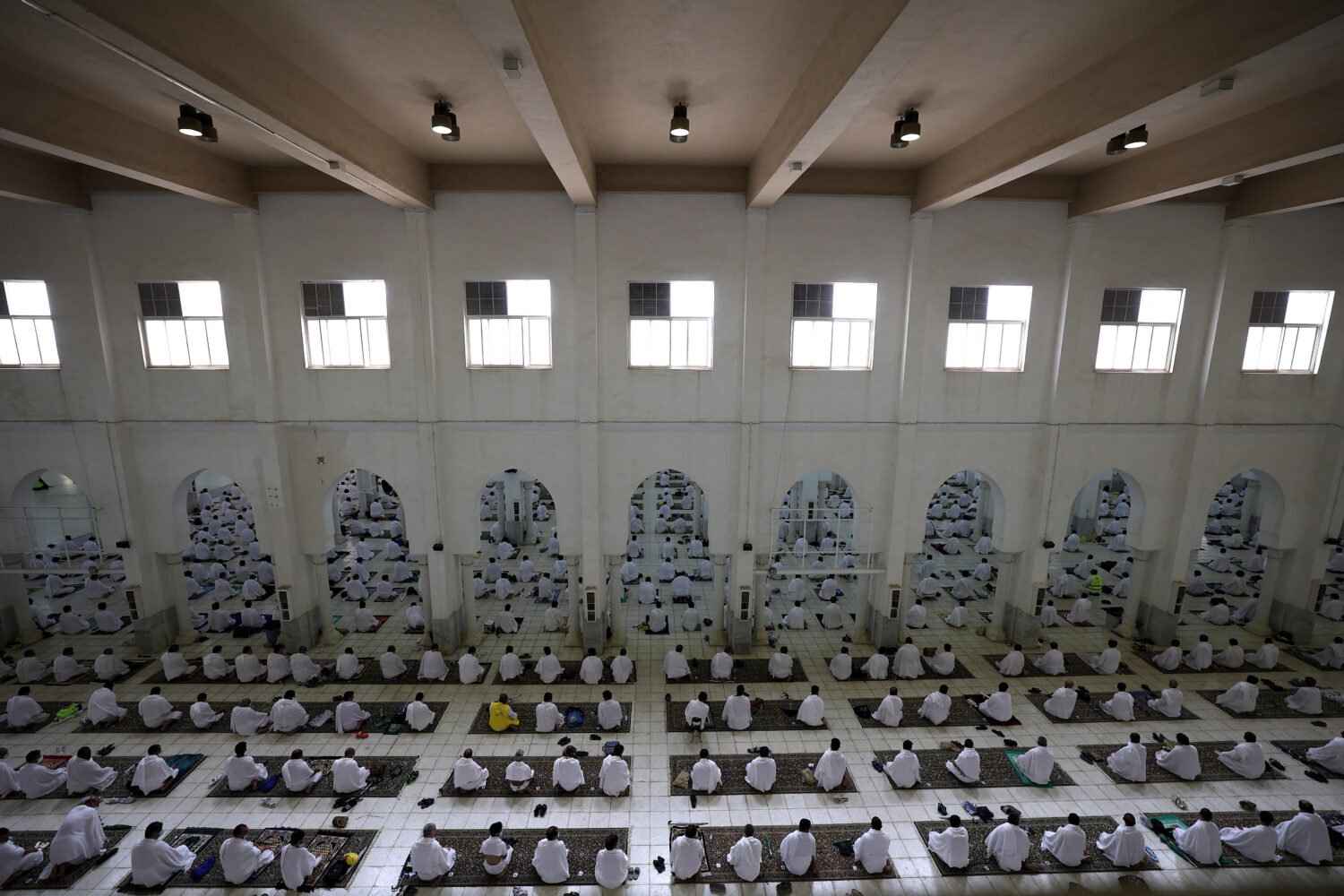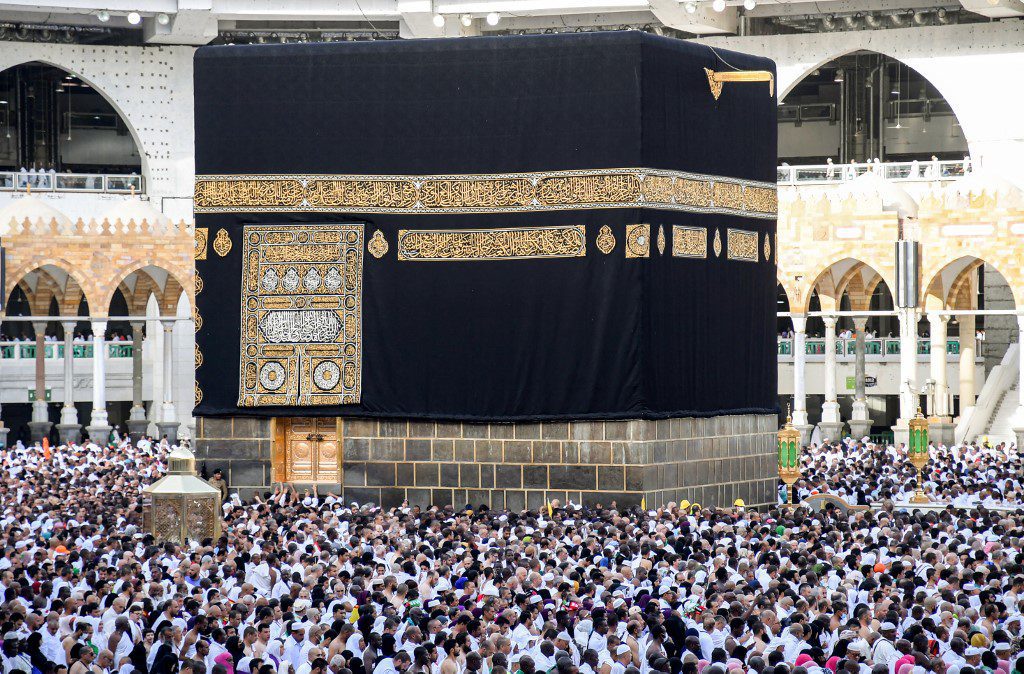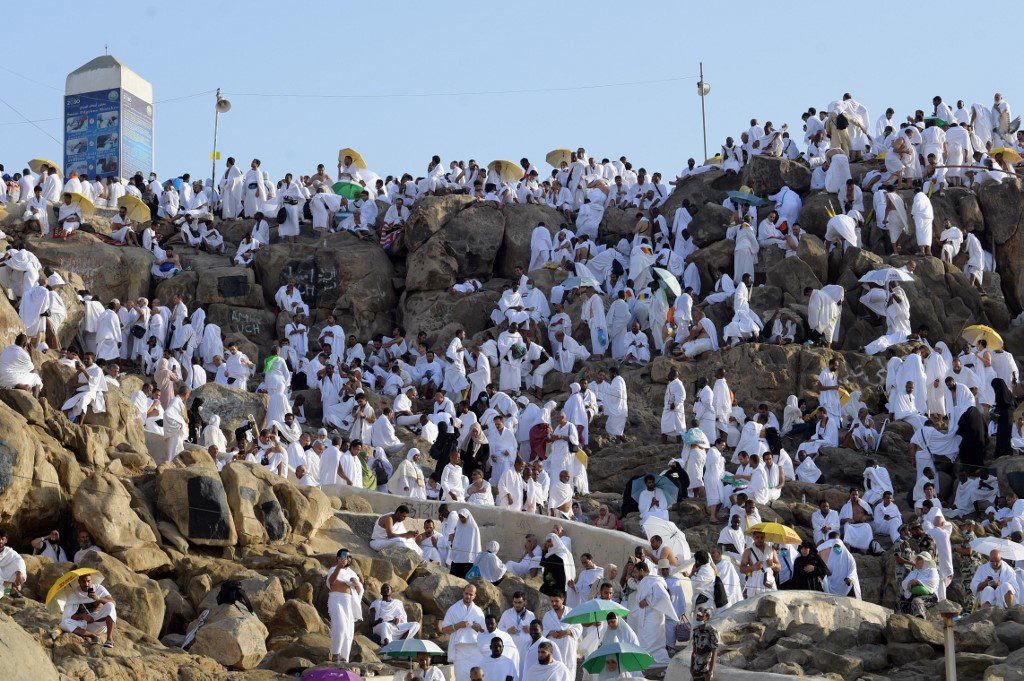
Hajj is the annual Islamic pilgrimage to the holy city of Mecca in Saudi Arabia. It is also the fifth pillar of Islam, and all Muslims are expected to make the journey at least once in their lives if they are able to do so. Hajj has certain rituals attached to it, which begin on the eighth day of Dhu al-Hijjah, the 12th and final month of the Islamic lunar calendar.
Hajj, which means ‘intent’ in Arabic, existed well before the emergence of Islam. Pre-Islamic Arabs used to go on pilgrimage to several places for blessing, prayer and to please God. Some of these places included Bayt ar-Rab, where the sun god Dhi al-Shara was located, and Bayt ar-Rabbah, where the goddesses Allat, Manat and al-Uzza were located.
In Islamic tradition, hajj was introduced during the time of Prophet Ibrahim (Abraham), from whom Muhammad descended. According to Islamic sources, God ordered Ibrahim, as a test of faith, to leave his wife Hajar and son Ismail in a desolate place now known as Mecca with only basic provisions. When the water ran out, Hagar ran back and forth between the Safa and Marwah hills seven times in search of a drink for her thirsty child. The story goes that a well then miraculously appeared and saved them both.
Some of the rituals of hajj originate from that story. Running between Safa and Marwah seven times is one of the rituals performed to emulate Hajar. Years later, Ibrahim received another order to build the Kaaba (the black cube Muslims face when they pray) in the same place.
Pre-Islamic Arabs used to perform hajj to the Kaaba from all directions and irrespective of religion and belief, such as the Hanafis (monotheists), Christians, Jews and others. They consecrated Dhu al-Hijjah, during which the hajj rituals are performed, as well as the month before and after it.
After the worship of idols and statues spread across the Arab Peninsula, Amr bin Luhay, one of the notables of Mecca, brought some of them into the Kaaba’s sanctuary, changing the hajj rituals. Some people, both men and women, used to walk around the Kaaba naked because they did not want to do the tawaf (circumambulation of the Kaaba at the beginning and end of the hajj) in clothes that they had put on as they disobeyed God. After that, the Quraysh tribe made clothes for the pilgrims, slaughtering sacrifices and smearing the Kaaba with their blood to please God.
Hajj in Islam
Hajj became obligatory for Muslims in the 9th year of the Islamic calendar (622 AD) and after the revelation of the Koranic verse reading: ‘Hence, pilgrimage unto the temple is a duty owed to God by all people who are able to undertake it’ (al-Imran, verse 97). Moreover, hajj has mawaqit zamaniyah (fixed times), mawaqit makaniyah (fixed places), pillars, duties and prohibitions.
The mawaqit zamaniyah are the months of Shawwal, Dhu al-Qadah and the first ten days of Dhu al-Hijjah, when it is considered valid to perform hajj after the umrah or ‘minor pilgrimage’.
The mawaqit makaniyah are the places outside Mecca at which pilgrims assemble and prepare themselves physically and spiritually for the hajj. Pilgrims must enter this sacred state, or ihram, before crossing the pilgrimage boundary, known as miqat (the plural of mawaqit) by performing certain cleansing rituals and wearing prescribed clothing. There are five mawaqit:
1. Dhu al-Hulaifah: The miqat allocated to pilgrims from the city of Medina and those to the north of it. It is 450 kilometres from Mecca.
2. Al-Juhfah: The miqat for pilgrims coming from the Levant and countries to the north and north-west. It is 204 kilometres from Mecca.
3. Yalamlam: The miqat for pilgrims from Yemen and countries to the south. It is 54 kilometres from Mecca.
4. Qarn al-Manazil: Located 95 kilometres from Mecca, this is the miqat for pilgrims from the east.
5. Dhatu Irq: The miqat for pilgrims from Iraq and others who travel along their route. It is also 94 kilometres from Mecca.

Those who live closer to Mecca than these mawaqit, as well as residents of Mecca, must enter ihram from their homes. As for the umrah, pilgrims must enter ihram at the nearest place outside al-Hill. Pilgrims whose travel route is to the right or left of these mawaqit must enter ihram when they move close to one of these mawaqit.
When pilgrims seeking to perform hajj or umrah arrive at the specific miqat designated for their specific origin, they put on ihram clothing. For men, this consists of two white unhemmed cloths that leave some parts of the body naked. Women can dress however they want as long as the garment covers their bodies, leaving only their face and hands exposed. They do not have to adhere to a specific colour either. Before entering ihram, it is recommended that pilgrims wash their bodies, clean their hair, cut their nails and put on perfume. From that moment on, pilgrims must comply with a number of prohibitions (explained below).
During the mawaqit zamaniyah, pilgrims may choose between three types of nusuk (rites) to be performed after ihram. These nusuk are:
Hajj al-Tamattu: When a pilgrim enters ihram with the intention of performing the umrah, and recites the prayer stating that intention. In this case, ihram for hajj is delayed until al-Tarwiyah, the eighth day of hajj, known in Arabic as the Day of Quenching Thirst, until sunset on Arafah, the ninth day of Dhu al-Hijjah. It is then obligatory for the mutamatti (pilgrim who enters ihram for umrah from the miqat designated for his or her country and completes the umrah to enter ihram for hajj from Mecca) to offer an animal sacrifice. A pilgrim who enters ihram for umrah, months before hajj, is called a mutamir, not a mutamatti.
Hajj al-Ifrad: When a pilgrim recites the prayer stating their intention to perform hajj. When the pilgrim arrives in Mecca, he or she does the tawaf al-qudum (arrival circumambulation of the Kaaba) and then the say (running between Safa and Marwah). The pilgrim remains in the state of ihram and is not released from it until after the throwing of pebbles at Jamrat al-Aqabah, the largest of three stone pillars in the valley of Mina, and cutting hair on the Day of Id. It is not obligatory for a hajj al-Ifrad pilgrim to offer an animal sacrifice.
Hajj al-Qiran: When a pilgrim combines the hajj and umrah and recites the prayer stating their intention to perform both, or the pilgrim enters into ihram for the umrah first and then plans to perform the hajj before embarking on the tawaf. The qarin (pilgrim performing the hajj al-Qiran) is similar to the mufrid (pilgrim performing the hajj al-Ifrad), with the exception that the qarin says a different prayer/intention and is obliged to offer an animal sacrifice.
Pillars of hajj
The hajj requires several rituals to be performed, the abandoning of which nullifies the pilgrimage. These are:
1. Entering ihram.
2. Standing on Mount Arafah: This takes place between dawn on Arafah (the ninth day of Dhu al-Hijjah) until the dawn of the next day.
3. Tawaf al-Ifadah: This tawaf begins at dawn on the Day of Id (the tenth day of Dhu al-Hijjah), but pilgrims who are unable to do it on this day can perform it on the Days of Tashriq (11th-13th days of Dhu al-Hijjah).
4. Running between Safa and Marwah, which is performed after the tawaf al-Ifadah or any other tawaf.
Duties

1. Al-Talbiyah: A prayer invoked by pilgrims, in which they say: ‘Here I am, O God, here I am. Here I am, You have no partner, here I am. Verily all praise and blessings are Yours, and all sovereignty, You have no partner.’ Pilgrims then enter into ihram for the hajj al-Qiran or hajj al-Ifrad until the throwing of the pebbles at Jamrat al-Aqabah.
2. Tawaf al-Qudum: The arrival circumambulation, which is obligatory according to some clerics and highly recommended and desirable according to others.
3. Tawaf al-Wada: The last tawaf pilgrims perform before departing Mecca, which is obligatory according to the majority of clerics and highly recommended and desirable according to Imam Malik.
4. Spending the night in Muzdalifah: It is now permissible to leave Muzdalifah after midnight for those who have other hajj-related activities to complete and for the weak and elderly.
5. Throwing seven pebbles at Jamrat al-Aqabah from sunrise on the Day of Id to zawal (beginning of the afternoon when the sun passes the meridian). Those who cannot throw the pebbles during that time may throw them before sunset; and those who cannot throw them before sunset may throw them on the first day of the Days of Tashriq.
6. Spending the night in Mina on the Days of Tashriq, although a longer stay is considered better. Those who leave within two days must leave before sunset otherwise it is obligatory for them to stay on.
7. Throwing the pebbles must be done in a particular order, starting with al-Jamrah al-Sughra (the smallest tower), al-Jamrah al-Wusta (the medium tower) and Jamrat al-Aqabah. Pilgrims throw seven pebbles at each pillar, starting at zawal and ending at sunset.
8. Saying a prayer of two rakahs (a rakah is the basic unit of Muslim prayers) in front of the Maqam Ibrahim (the stone used by Prophet Ibrahim throughout the building of Kaaba) or any place in the Great Mosque of Mecca.
9. Shaving or cutting hair for men, but it is not obligatory for women to do so.
Pilgrims who fail to perform any of these duties are obliged to offer an animal sacrifice, by slaughtering a sheep or the like. They may not eat the sacrifice or hand it out as a gift but can only give it away as charity.
Prohibitions
Once seeking Hajj or Umrah, It is prohibited for a hajj pilgrim to do any of the following :
1. Remove any hair from their head or body or cut their nails.
2. Use perfume or fragrance.
3. Have sexual intercourse and/or perform related physical acts, get married or engaged.
4. Kill animals or insects or hunt. Cutting trees is not prohibited except trees inside the borders of the Great Mosque of Mecca.
5. Wear sewn or tight clothing that shows the details of the body or part of it (for men).
6. Cover the head with a hat or the like (for men).
7. Wear the burqa and niqab that covers the face, although it is permissible to wear sewn clothes (for women).
Pilgrims who break any of these prohibitions out of forgetfulness, ignorance or necessity are not considered sinful; those who break any of them out of necessity are not considered sinful but are obliged to offer an animal sacrifice; but those who break any of them deliberately without excuse are considered sinful and must also offer an animal sacrifice. However, having sexual intercourse nullifies the hajj if the act is committed before the pilgrim observes the first tahallul (ending the ritual state for hajj and umrah).

